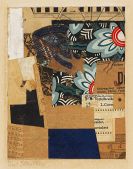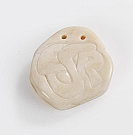
Marcel Duchamp
1887 Blainville
1968 Neuilly-sur-Seine
Marcel Duchamp, born in Blainville bei Rouen on July 28, 1887, was a key figure of Dadaism. The artistic impulse for this was above all the "ready-mades" of the French painter, sculptor and object artist, who carried traditional art, conventions and forms into absurdity on the threshhold of the 20th century.
In 1904, Marcel Duchamp went to Paris, where he began with traditional portraits and impressionistic landscapes. While his siblings has already made names for themselves – the painter Jacques Villon, the sculptor Raymond Duchamp-Villon and the painter Suzanne Duchamp – Marcel earned his living through illustrations, for example for the "Courrier français".
In 1910, a few works emerged that showed the influence of Paul Cézanne, and one year later, he oriented himself towards Cubism and Futurism, inspired by Georges Braque and Guillaume Apollinaire. During this period he created a picture with the different phases of the course of a movement, similar to chronophotography.
Independent of Dadaist movements, Marcel Duchamp was already experimenting with objects manufactured in series in 1913. He took them out of their actual context and "through the mere choice of the artist raised them to the status of an art object", such as his well-known ready-made "Bicycle Wheel" (1913).
His ironic distance to the world of things as well as to art was modern, avant-garde and scandalous, such as when he declared a used urinal a work of art and submitted it to a contest ("Fontaine" from 1914).
After World War I broke out, Duchamp emigrated to New York, and there he got to know Man Ray, Katherine S. Dreier and Mr. and Mrs. Arensberg, his greatest patrons and passionate collectors of his art.
In 1921, the first and only edition of the journal "New York Dada" appeared, published by Marcel Duchamp and Man Ray.
After a few experiments with kinetic problems and optical devices, Marcel Duchamp left America, went to Paris and beginning in 1925, devoted himself there almost exclusively to playing chess (in this context, the film "Dadascope" appeared in 1958, with Duchamp and the chess master Larry Evans playing chess in water). In 1941, the artist packed his entire artistic production in the form of small ripostes in a box, "La boîte en valise", and one year later Duchamp initiated a large Surrealist exhibition in New York. After the war, further ready-mades were produced, which strongly influenced the object art of the time.
On October 2, 1968, Marcel Duchamp died in Neuilly-sur-Seine. His entire oeuvre influenced Dada to the same extent as the theories of Freud and the experience of World War I. Today, the greater part of his work is in the Philadelphia Museum of Art.

Would you like to sell a work by Marcel Duchamp?
Infos for seller






